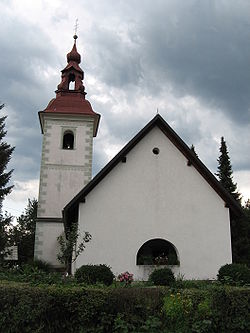
Breg, Žirovnica
Encyclopedia

Žirovnica
Žirovnica is a municipality in Slovenia. It is located in the historic Upper Carniola region, on the southern slope of the Karavanke mountain range, close to the border with Austria...
municipality in the Upper Carniola
Upper Carniola
Upper Carniola is a traditional region of Slovenia, the northern mountainous part of the larger Carniola region. The centre of the region is Kranj, while other urban centers include Jesenice, Tržič, Škofja Loka, Kamnik, and Domžale.- Historical background :...
region of Slovenia
Slovenia
Slovenia , officially the Republic of Slovenia , is a country in Central and Southeastern Europe touching the Alps and bordering the Mediterranean. Slovenia borders Italy to the west, Croatia to the south and east, Hungary to the northeast, and Austria to the north, and also has a small portion of...
.
Breg is first mentioned in 1348. The older part of the settlement lies close to the banks of the river Sava
Sava River
The Sava is a river in Southeast Europe, a right side tributary of the Danube river at Belgrade. Counting from Zelenci, the source of Sava Dolinka, it is long and drains of surface area. It flows through Slovenia, Croatia, along the northern border of Bosnia and Herzegovina, and through Serbia....
and in the vicinity of the gothic church of St Radegund
Radegund
Radegund was a 6th century Frankish princess, who founded the monastery of the Holy Cross at Poitiers. Canonized in the 9th century, she is the patron saint of several English churches and of Jesus College, Cambridge.-Life history:Radegund was born about 520 to Bertachar, one of the three kings...
.
The church is first mentioned in 1468 as a church belonging to the Diocese
Diocese
A diocese is the district or see under the supervision of a bishop. It is divided into parishes.An archdiocese is more significant than a diocese. An archdiocese is presided over by an archbishop whose see may have or had importance due to size or historical significance...
of Radovljica
Radovljica
Radovljica is a town and a municipality in in the Upper Carniola region of northern Slovenia. The municipality has around 18,000 inhabitants and an area of 118 km²...
, but is an older building with Romanesque
Romanesque architecture
Romanesque architecture is an architectural style of Medieval Europe characterised by semi-circular arches. There is no consensus for the beginning date of the Romanesque architecture, with proposals ranging from the 6th to the 10th century. It developed in the 12th century into the Gothic style,...
foundations, partly reflected in the shape of nave and its flat ceiling. Most of the remaining structure is from the mid 17th century. There are two entrances to the church, one from the 14th century and a dated Renaissance
Renaissance
The Renaissance was a cultural movement that spanned roughly the 14th to the 17th century, beginning in Italy in the Late Middle Ages and later spreading to the rest of Europe. The term is also used more loosely to refer to the historical era, but since the changes of the Renaissance were not...
portal from 1629. The belltower with its typical onion-shaped roof is baroque. There are frescoes of St Radegund and St Laurence on the southern wall. St Michael fighting a dragon is represented on the northern wall and there is a baroque painting of St Christopher on the southern exterior. There is evidence of a wall encircling the church, probably built in the 15th century to protect local inhabitants against Turkish raids
Ottoman wars in Europe
The wars of the Ottoman Empire in Europe are also sometimes referred to as the Ottoman Wars or as Turkish Wars, particularly in older, European texts.- Rise :...
in the area. This was demolished in the 17th century when the church was being rebuilt. A 1994 archaeological excavation around the church also revealed graves from the later period of slavic
Slavic peoples
The Slavic people are an Indo-European panethnicity living in Eastern Europe, Southeast Europe, North Asia and Central Asia. The term Slavic represents a broad ethno-linguistic group of people, who speak languages belonging to the Slavic language family and share, to varying degrees, certain...
settlement in the area (9th to 19th century AD).
The newer part of the village lies further north towards the main road. There are open fields towards the east of the village whilst it borders onto a forest along the banks of the Sava towards the west.

